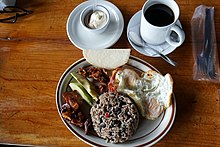Gallo pinto
 Gallo pinto, served at breakfast with fried eggs, plantain, bacon, avocado, a corn tortilla and sour cream | |||||||
| Course | Breakfast, lunch, dinner | ||||||
|---|---|---|---|---|---|---|---|
| Place of origin | Costa Rica and Nicaragua [1][2][3] | ||||||
| Region or state | Central America | ||||||
| Serving temperature | Hot | ||||||
| Main ingredients | Rice, Beans | ||||||
| Variations | Regional variations | ||||||
Food energy (per serving) | 200 kcal (837 kJ) | ||||||
Nutritional value (per serving) |
| ||||||
Gallo pinto or gallopinto[4] is a traditional dish from Central America. Consisting of rice and beans as a base, gallo pinto has a long history and is important to Costa Rican and Nicaraguan identity and cultures, just as rice and beans variations are equally important in many Latin American cultures as well.
The beans in gallo pinto are quickly cooked until the juice is almost consumed, then combined with prepared rice and other ingredients such as cooked bell peppers, chopped onions, and garlic.
Etymology[]
Gallo pinto means "spotted rooster" in Spanish. The name is said to originate in the multi-colored or speckled appearance that results from cooking the rice with black or red beans. The term may also be shortened depending on the region.
History[]
It is uncertain and disputed which country is the precise origin of the dish.[5] Both Costa Rica and Nicaragua claim it as their own, and its origin is a controversial subject between the two countries.[1][2][3]
Gallo pinto is one of many various Latin American plates which involve the preparation of the most integral ingredients for many cultures: rice and beans. Gallo pinto is considered to be a product of mestizos; a combination of beans, cultivated by Indigenous people of pre-Columbian time, and rice, a grain introduced by the Spanish. The cooking and preparation is heavily influenced by African cooking.[6][7]
Rice, originally from Asia, was introduced by Arabs in Spain and became a main but versatile ingredients in the fifteenth and sixteenth century. With the Spanish colonization of the Americas, the Spanish introduced rice quickly to Mexico and South America. It is suggested that within the eighteenth century, the cultivation of rice became relevant to Central America. Asian rice was cultivated by Africans in the neolithic period, and with their arrival to the Americas as slaves by Europeans, they were already accustomed to eating rice. So this occurred as well with beans, which were cultivated centuries prior in the Americas. On their travels to America, slaves were given bowls and a wooden spoon from which they ate twice a day. They ate primarily beans and European or African rice, along with maize, yams, cassava and sponge cake.[7]
As Africans were forced to settle in the continent, various forms of rice and beans began to take form. Because the Americas had many types of beans cultivated by Indigenous people, they gave rise to a range of dishes when combined with rice.
Regional variations[]
Gallo Pinto is found in Costa Rica, Guatemala, Nicaragua and Panama. In the Caribbean areas of these countries it is possible to find rice and beans, a similar dish prepared with coconut milk.
Costa Rica[]
In Costa Rica there are two main variations:
- Valle Central: gallo pinto is more moist, less greasy and is seasoned with chili, cilantro and onions. One variant includes Lizano sauce
- Guanacaste: with a more fatty and roasted gallo pinto; made with red beans
Nicaragua[]
In Nicaragua, Gallo Pinto is made mainly with red beans. In addition, vegetable oil is used for cooking (includes onions). The Gallo Pinto can be eaten in Nicaragua at any time and is the main companion of the different dishes sold in a fritanga (food stall).
See also[]
- List of legume dishes
- Rice and beans#International dishes and variations, for a list of similar dishes made with rice and beans.
 Food portal
Food portal
References[]
- ^ Jump up to: a b http://www.nicaraguafood.org/gallo-pinto.php
- ^ Jump up to: a b "Costa Rica vs Nicaragua: Who Really Invented Gallo Pinto?".
- ^ Jump up to: a b "Gallo Pinto, Costa Rica's National Dish - Latin America Travel Company". 27 April 2017.
- ^ Royal Spanish Academy y Association of Academies of the Spanish Language (2014). «gallopinto». Diccionario de la lengua española (23.ª edición). Madrid: Spain. ISBN 978-84-670-4189-7. Consulted October 19, 2018.
- ^ Preston-Werner, Theresa (2020-07-10). "Gallo Pinto: Tradition, Memory, and Identity in Costa Rican Foodways". Journal of American Folklore. 122.
- ^ "Ambassade Costa Rica -- Gastronomía costarricense" (in Spanish). Archived from the original on 30 March 2012. Retrieved 29 February 2012.
- ^ Jump up to: a b Marjorie, Ross (2001). Entre el comal y la olla: fundamentos de gastronomía costarricense (in Spanish). Editorial Universidad Estatal a Distancia. pp. 62–64. ISBN 9968-31-128-6.
- Legume dishes
- Rice dishes
- Costa Rican cuisine
- National dishes
- Nicaraguan cuisine
